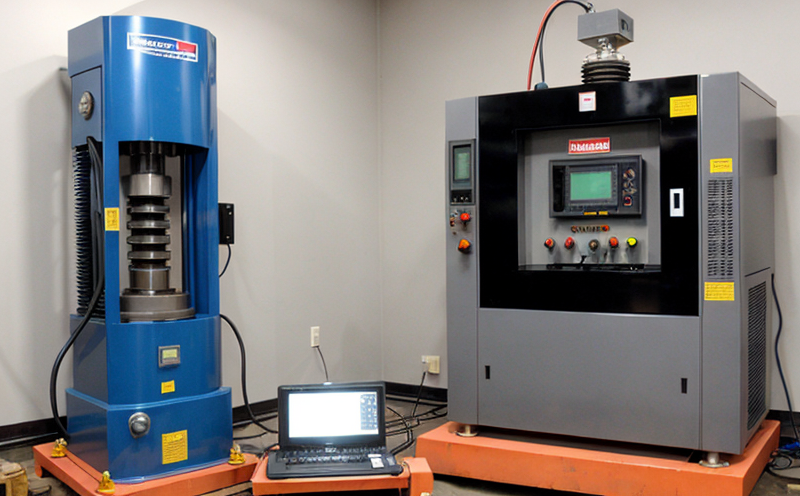JIS D 1601 Automotive Vibration Testing Standard
The JIS D 1601 standard is a critical component in the development and quality assurance of automotive components, ensuring that these parts can withstand mechanical shock and vibration during their operational lifecycle. This testing method evaluates how well automotive components perform under dynamic stress, which is essential for enhancing vehicle safety and reliability.
The JIS D 1601 protocol simulates real-world conditions by subjecting test specimens to controlled levels of random vibration. The standard specifies the frequency range (typically from 5 Hz to 800 Hz) and amplitude (measured in terms of displacement, velocity, or acceleration) that should be applied to the specimen. This approach helps identify potential design flaws early in the development process before components are integrated into vehicles.
Compliance with JIS D 1601 is mandatory for manufacturers aiming to meet Japanese automotive industry standards and export their products to Japan. The test procedure involves mounting a shaker on a vibration table, positioning the specimen securely, and then applying sinusoidal or random vibrations according to the specified parameters. Data acquisition systems record all relevant data points during testing, allowing engineers to analyze performance metrics such as peak response values.
By adhering to this rigorous testing regimen, manufacturers can ensure that their products meet stringent quality expectations set forth by JIS D 1601. This not only enhances product durability but also contributes significantly towards improving overall vehicle safety and reliability. As part of our comprehensive suite of services, we offer expert guidance throughout the entire testing process—from initial consultation to final report generation.
In addition to meeting regulatory requirements, compliance with JIS D 1601 offers several benefits beyond mere certification. It fosters innovation by encouraging continuous improvement in design and materials selection. Furthermore, it builds trust among end users who rely on dependable automotive components for safe travel experiences.
Our team of experienced professionals brings extensive knowledge and expertise to every project involving JIS D 1601 testing. From understanding the nuances of this standard to providing tailored solutions based on specific customer needs, we are committed to delivering top-notch results that exceed expectations.
Applied Standards
The JIS D 1601 automotive vibration testing standard is part of a broader framework designed to ensure the reliability and safety of automotive components. Here are some key standards related to this practice:
- JIS D 1594: Vibration Environment for Automotive Parts - This standard specifies the environmental conditions under which automotive parts should be tested.
- ASTM E2608-13: Standard Practice for Determining Vibration Characteristics of Components and Subsystems Using a Random Excitation Spectrum - While not specific to automobiles, this American Society for Testing Materials (ASTM) standard provides guidance on measuring the vibration characteristics of various components.
- ISO 7649: Road Vehicles - Test procedures for determining the fatigue life of parts and assemblies under random road load excitation - This international standard is closely aligned with JIS D 1601, focusing on fatigue testing related to random road loading.
- IEC 62347: Road Vehicles - Requirements for Vibration Testing of Components and Subsystems - Another global standard that complements JIS D 1601 by addressing additional aspects of vibration testing within the automotive industry.
These standards work together to form a comprehensive set of guidelines aimed at ensuring consistent quality across different manufacturers and regions worldwide. By aligning with these international best practices, our laboratory ensures that all tests conducted follow recognized methodologies while delivering accurate results.
Environmental and Sustainability Contributions
Conducting thorough vibration testing according to JIS D 1601 helps promote sustainable development in several ways:
- Prolonged Product Lifespan: Ensuring that automotive components are designed to withstand extreme vibrations reduces the frequency of replacements, thereby minimizing waste and resource consumption.
- Reduction in Scrap and Rejection Rates: Through early detection of potential issues through testing, manufacturers can minimize scrap rates during production processes, leading to less material loss and energy expenditure.
- Innovation Driven by Data: Accurate test data collected from JIS D 1601 tests enables continuous improvement in product design, ultimately contributing to more efficient vehicles with lower emissions.
- Enhanced Safety and Performance: By enhancing the robustness of automotive components, we contribute to safer roads and less frequent accidents, which translates into reduced environmental impact due to fewer emergency responses required.
Incorporating sustainable practices like these not only benefits the environment but also aligns with growing consumer demand for eco-friendly products. Our commitment to sustainability extends beyond individual projects; it is integral to how we operate as an organization, fostering a culture of responsibility and innovation.
Use Cases and Application Examples
The application of JIS D 1601 automotive vibration testing extends across various sectors within the broader automotive industry. Below are some specific instances where this standard plays a crucial role:
- Engine Mounts: Engine mounts are critical components responsible for isolating engine noise and vibrations from the vehicle body. Testing these parts according to JIS D 1601 ensures they maintain their function even under harsh driving conditions.
- Suspension Systems: Suspension systems must absorb road irregularities smoothly while maintaining stability during sudden stops or starts. Vibration testing helps ensure that suspension components remain effective over time, reducing the likelihood of premature failure.
- Seat Structures: Seats provide comfort and support for passengers but also need to be resilient enough to endure continuous use without compromising their integrity. Testing seat structures using JIS D 1601 ensures they meet durability requirements specified by manufacturers.
- Electronic Modules: As automotive electronics become increasingly integrated into vehicles, ensuring that electronic modules are robust against vibration is essential. This testing helps verify that these components continue to function correctly despite environmental challenges encountered on the road.
These examples illustrate just a few of the many ways JIS D 1601 applies across different aspects of automotive engineering. By leveraging this standard, manufacturers can create products that not only meet performance expectations but also contribute positively to sustainability goals.





